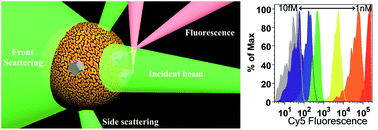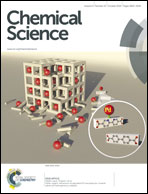Plasmonic micro-beads for fluorescence enhanced, multiplexed protein detection with flow cytometry†
Abstract
Micro-bead based multiplexed protein immunoassays have experienced rapid growth in the past decade. Thus far, bead based protein assays have relied on the bulky 240 kDa protein phycoerythrin (PE) as the reporter dye to afford a sufficient detection signal and sensitivity, taking advantage of the 25 fluorophores in each protein. Here, we report the synthesis of gold nano-island coated glass beads (4–8 μm) through a two-step seeding-and-growth approach. We developed flow cytometric bead assays with sensitivities as low as 10 fM (∼0.2 pg ml−1) by utilizing the strong fluorescence enhancement of small molecule fluorophores (Cy-5) on the plasmonic gold (pGOLD) beads. By using different fluorescence tags to label the gold beads and varying the bead size, we obtained multiplexed plasmonic gold beads for the quantification of human cytokine IL-6, IFN-gamma, IL-1 beta, VEGF and an ovarian cancer biomarker CA-125 in biologically relevant media. The low limit of detection surpassed those of glass bead based immunoassays by 2 orders of magnitude, demonstrating the potential of plasmonic gold beads for sensitive protein biomarker quantification.


 Please wait while we load your content...
Please wait while we load your content...